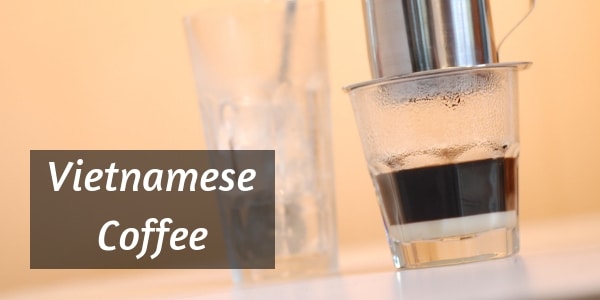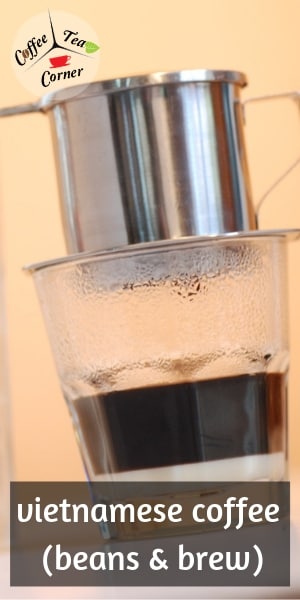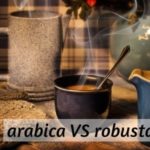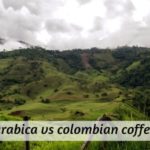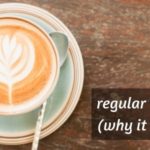Have you ever wondered why Vietnamese coffee tastes so delicious ? Aside from the condensed milk. You've never heard of Vietnamese coffee or coffee beans ? Well then, let's clear things up for everyone.
Some people know about Vietnamese coffee, some don't, some might wonder if it's not just coffee made in Vietnam. And they'd be right, it is made there.
It's how the bean is processed and brewed that makes it special.
Table of Contents
What kind of coffee do they grow in Vietnam ?
The vast majority of coffee beans grown in Vietnam are Robusta beans. They're very popular there because in the beginning, when coffee was introduced by the French occupation (1800s) it had a hard time growing.
So after a few failed attempts of growing serious amounts of coffee, they finally settled on Robusta beans. These beans are survivors, they repel insects, they're poisonous to most insects actually.
And they can live in harsher conditions than the Arabica beans. So this means Robusta had a good chance in Vietnam, and that's what they're still growing today.
Robusta happens to have a large yield, so that means a Robusta and an Arabica tree of the same size will produce different amounts of cherries. The Robusta will yield more.
Keep in mind that Robusta is the coffee bean that tastes the most like 'burnt tires' and 'dirt', according to many people. That's only because of how bitter and earthy Robusta beans taste.
Robusta can have it great moments though, so don't look at it that way.
Their much higher (double !) caffeine content than Arabica makes them more bitter, and they contain half the sugar and fats of an Arabica bean. So, Robusta isn't for everyone.
This is also why Arabica is so loves across the world. it's a much milder, and easier to love coffee bean. It also takes well to developing different aromas (various breeds).
A comparison of Robusta and Arabica beans will help you understand these points better.
But the Vietnamese have fallen in love with their Robusta beans, and you'll see how they turned them into little treasures.
What makes Vietnamese coffee beans special and tasty ?
The special thing about Vietnamese coffee beans is how they're roasted. You see Robusta beans are fairly bitter, and they have very little sugar and fats.
So, the Vietnamese add sugar and butter to the roasting process. This gives the beans a much deeper flavor, and almost like caramel to a point. Sometimes the oil used is actual clarified butter, sometimes it's mixed with a bit of vegetable oil.
Often times a bit of vanilla or cocoa are added as flavorings to the beans, and that all gives the beans a very special and deep taste.
The roasting process is slow and takes a longer time, so the roast is deepened. Most of the time the beans are overroasted, on purpose. Partly because of how the Vietnamese have learned to love their coffee, and partly to give it an extra kick.
As if a bitter Robusta needs an extra kick, but I'm not the one roasting, am I ?
A deeper, darker roast will usually make the beans a bit drier as well, which makes the whole coffee itself a bit thicker because of the faint coffee dust present in the cup. You'll see soon this is something that's very important in how the coffee is made in Vietnam.
(If you like this article so far, you can pin it to your Pinterest board by clicking the image below. The article continues after the image.)
There's only one way to brew Vietnamese coffee
There are many things people don't know very well about Vietnam, aside from the food. One of them is how they like to brew their coffee.
The phin, a sort of single-serve filter, is how coffee in Vietnam is usually served. This is because it was easy to come by and make from scratch back when coffee was fist consumed locally, and also to take advantage of the great roast.
Coffee made in a filter means water stays in contact with the coffee grounds for longer than an espresso, for example, so they will steep all the flavor and nutrients and caffeine out of those coffee grounds.
So a deep, dark French-style roast that gave you beautiful unburnt but well roasted beans is meant to be enjoyed from a slow-drip filter.
The grinding for this kind of coffee is supposed to be of a medium size, although you could go just a bit smaller than that.
So once you've ground your coffee, you will place the small coffee filter over your empty cup of coffee. Add hot water, add the coffee, and let sit/drip until you're happy with the coffee.
This is a process which, like tea, requires you to learn when to stop brewing and choose the right moment. It's a great way to bond with friends and family since it's a unique experience.
Taste and texture are very specific in Vietnamese coffee
The whole brewing processed I explained gives you a thicker coffee than usual. There is less water than a Western filter, in fact it's more like an espresso in terms of creaminess.
Taste is on the bitter/dark roast side, but more like the almost-burnt edges of cake. Those are always flavorful and the caramelization from the sugars is giving everything a right taste.
Traditionally Vietnamese coffee is made with condensed milk instead of fresh milk. This is because condensed milk was easier to come by, and easier to store some decades ago. in a hot and humid climate like Vietnam.
Although you can add fresh milk, it's not how thins are usually done. So condensed milk is the way to go when going for the authentic taste.
Keep in mind that condensed milk is sweetened, so no other sugar is really needed for the cup of coffee.
And the coffee to milk ratio is almost even, which lands you in an even tastier coffee cup.
Imagine the strongest possible cup of coffee, made from the strongest coffee bean out there (Robusta), and how much of a deep flavor it would bring you. Now imagine that flavor roasted in butter and sugar, and then add condensed milk to make things even more concentrated.
Vietnamese coffee really is out of this world, and it's the most condensed and essence-like coffee, right after espresso.
Making you own Vietnamese coffee at home
Of course, you can make your own Vietnamese coffee, right at home. Traditionally you need some condensed milk and ice. There are a few variations, but you can adjust it to you liking.
You can always take your Vietnamese coffee black, just be warned that it's a thicker brew and you will need a glass of water right after it.
You will need the 2 main ingredients, like the beans themselves and the phin filter. So let me help you out here.
The Vietnamese coffee beans
The Vietnamese coffee beans aren't easy to come by since most of the available coffees online are already ground coffees.
For example this one is ground Vietnamese coffee from Trung Nguyen. they're a Vietnamese brand and seem to be the few exporting out of Vietnam.
This is a two-pack offer they have, and as such you're met with a full kg/2.2 lbs of ground coffee. It's vaguely chocolatey so if that's something you like then you're going to love this one.
You'll find it easy enough to use along with the phin filter. Condensed milk is easy to find, and most fridges can make ice. So you're pretty much set with making your own Vietnamese coffee !
You can check the listing on Amazon here, and read the reviews as well.
The single-serve filter (phin)
The phin is not really hard to come by, but you'd have to look in some every specific places to find one. There are several sizes of this filter, according to how much coffee you want.
Onto the filter, this one is from a reputable seller, and does come in any size you need it. I'm showing you the medium one, for an 8 oz/226 ml coffee since this is what most people (including me) drink.
The instructions that come with the filter are pretty clear, and the phin is dishwasher safe as well. If you're using large-enough ground coffee there shouldn't be any problems.
You can check the listing on Amazon here, and read the reviews as well.
This is one coffee you'll have to know from the start if you want a large or small. The way the phin works is that the coffee grounds are 'trapped' between two filter disks, which means the water will sit with the coffee for longer, giving you a stronger brew.
One of the reason this kind of coffee takes longer to drip and brew until finished. But the end result is always a very strong coffee. And when it comes to iced coffee, this is probably the best method since the ice will water down the drink just enough.
The brewing method
Grab your favorite cup of coffee. Place your filter right over your cup. Make sure the cup is heated beforehand, so you won't lose any important heat from the coffee itself.
Add your ground coffee into the phin, and make sure you distribute it evenly for a great brew. Place the little lid/filter on top and add about 2 tablespoons of near-boiling water to the grounds to bloom them.
When the coffee grounds bloom they release some CO2 and you will also notice whether your coffee is fresh or not. If it is, you'll see some dramatic blooming and a fair amount of froth on the surface. They will settle down after a few seconds.
After you've bloomed your coffee, you can slowly add the rest of your hot water into the phin. Make sure you've got every part of the coffee grounds covered with water.
Don't shake or jiggle the filter, since this method relies on a slow drip. This means the coffee grounds won't clog up the holes in the filter is you don't mess with them. If you leave it alone, the water will slowly drip from the filter right int your cup.
The usual brewing time is about 4 minutes. But this also depends on how strong you want your coffee.
Try making your coffee with the usual amounts you'd use, and see if you like it. You might need to adjust, since every brewing method has its effects on the water to coffee ratio.
After you coffee is done dripping, you can gently remove the phin from your cup. You should be met with a dark, fragrant coffee and you can stir in the milk and ice if you want to serve it that way.
If you want an iced Vietnamese coffee, then it would be best to pour the brew directly into a tall glass that's already been filled with ice and as much condensed milk as you like, then stir very well.
You can of course have your coffee black, unsweetened and no milk. But traditionally at least a bit of condensed milk is added. And seeing as Vietnam is a very warm and humid country, ice is always welcome in most drinks.
Final thoughts
The whole beauty of the Vietnamese coffee, and the beans themselves, is that they're at first thought alien to a Westerner. But, they remind me so much of tea and tea brewing in general.
Brewing Vietnamese coffee in its dedicate phin is a bit of a ritual, much like brewing tea in its dedicated pot is a ritual. It's relaxing, you're focused on what you're doing, and it's a welcome breather in the middle of a busy day.
If you want to know more about coffee or tea, feel free to check the related articles below. Who knows what else you might find ?

